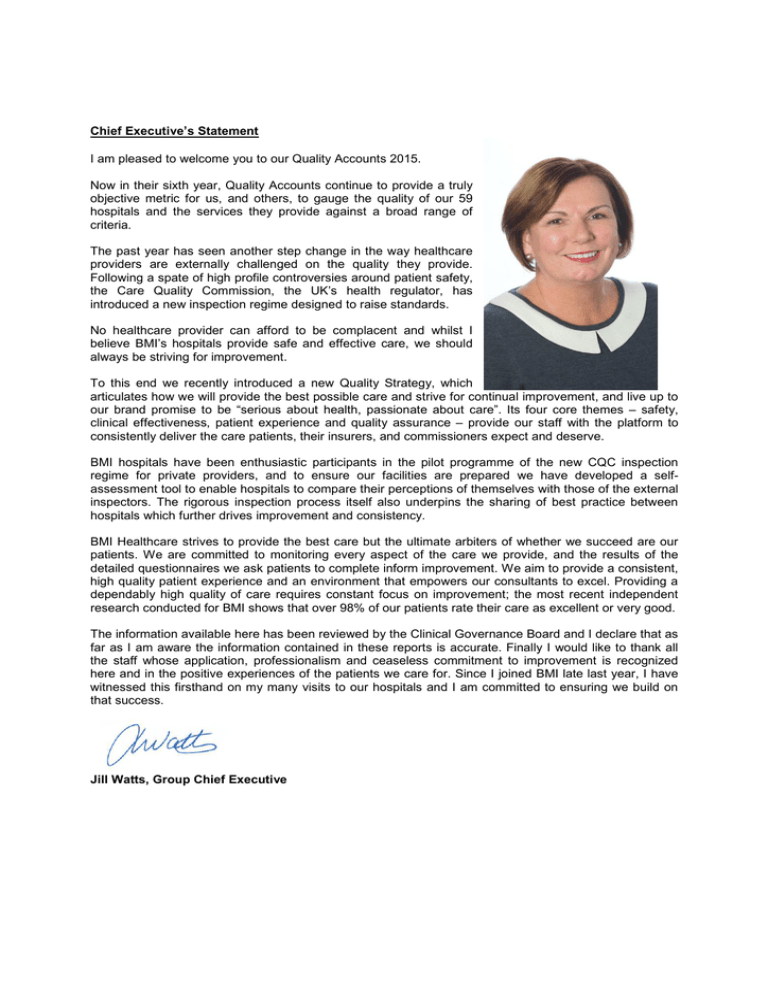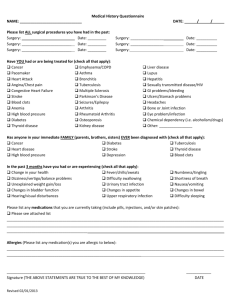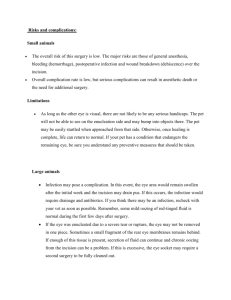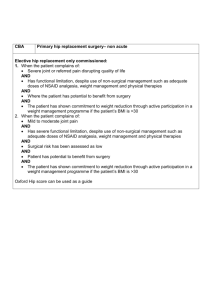
Chief Executive’s Statement
I am pleased to welcome you to our Quality Accounts 2015.
Now in their sixth year, Quality Accounts continue to provide a truly
objective metric for us, and others, to gauge the quality of our 59
hospitals and the services they provide against a broad range of
criteria.
The past year has seen another step change in the way healthcare
providers are externally challenged on the quality they provide.
Following a spate of high profile controversies around patient safety,
the Care Quality Commission, the UK’s health regulator, has
introduced a new inspection regime designed to raise standards.
No healthcare provider can afford to be complacent and whilst I
believe BMI’s hospitals provide safe and effective care, we should
always be striving for improvement.
To this end we recently introduced a new Quality Strategy, which
articulates how we will provide the best possible care and strive for continual improvement, and live up to
our brand promise to be “serious about health, passionate about care”. Its four core themes – safety,
clinical effectiveness, patient experience and quality assurance – provide our staff with the platform to
consistently deliver the care patients, their insurers, and commissioners expect and deserve.
BMI hospitals have been enthusiastic participants in the pilot programme of the new CQC inspection
regime for private providers, and to ensure our facilities are prepared we have developed a selfassessment tool to enable hospitals to compare their perceptions of themselves with those of the external
inspectors. The rigorous inspection process itself also underpins the sharing of best practice between
hospitals which further drives improvement and consistency.
BMI Healthcare strives to provide the best care but the ultimate arbiters of whether we succeed are our
patients. We are committed to monitoring every aspect of the care we provide, and the results of the
detailed questionnaires we ask patients to complete inform improvement. We aim to provide a consistent,
high quality patient experience and an environment that empowers our consultants to excel. Providing a
dependably high quality of care requires constant focus on improvement; the most recent independent
research conducted for BMI shows that over 98% of our patients rate their care as excellent or very good.
The information available here has been reviewed by the Clinical Governance Board and I declare that as
far as I am aware the information contained in these reports is accurate. Finally I would like to thank all
the staff whose application, professionalism and ceaseless commitment to improvement is recognized
here and in the positive experiences of the patients we care for. Since I joined BMI late last year, I have
witnessed this firsthand on my many visits to our hospitals and I am committed to ensuring we build on
that success.
Jill Watts, Group Chief Executive
Hospital Information
The Hospital
BMI The Esperance Hospital offers a 24 hour a day service with 38 beds, all of which have ensuite facilities, telephone and satellite television. A two-bedded High Dependency Unit offers
level 1 postoperative high dependency care. We have 95 well-respected local Consultants who
offer the following specialties: Orthopaedics, Urology, Gynaecology, Oncology, Ophthalmic
surgery, Ear Nose and Throat surgery, Colorectal surgery, Breast surgery, General surgery ,
Plastic Surgery, Cosmetic surgery, Endoscopy and Assisted Conception. We also offer a
comprehensive list of outpatient specialities including haematology, neurology, rheumatology,
endocrinology, oncology, sleep studies, dermatology, cardiology, health screening and travel
vaccination clinics.
The Operating Suite comprises 3 Operating Theatres which include the assisted conception
theatre, and a highly equipped recovery room. A fully accredited BMI Unit provides off site
decontamination services.
Pathology, Pharmacy, and Physiotherapy Departments support these services, together with
Diagnostic Imaging, including Digital Mammography, Ultrasound, Bone Densitometry, CT and
MRI.
In-patient care is provided on two wards. A team of well-trained, skilled and professional nurses
led by the Director of Clinical Services provides individual care to patients. The High
Dependency Unit is staffed by nurses with Critical Care Training and up to date competencies
Outpatient services are provided in our Consulting Room Suite, comprising 8 Consulting Rooms
and a preoperative assessment service
The Hospital has been undergoing a rolling refurbishment plan.
This year so far the following projects have been completed.• The Endoscopy unit has been completely refurbished.
• The H.D.U has also been fully refurbished with new monitoring equipment.
• The oncology rooms have been refurbished .
• A new top of the range specification scalp cooling system has been purchased.
• The operating theatres have had a new laminar flow system and operating lights
installed.
• 5 patient rooms have been updated and there is a plan to update all rooms on a rolling
programme going forward.
• The ward corridor walls have been decorated.
• The outpatient department roof has been replaced.
• There is also an outpatient consulting rooms refurbishment plan which has already
completed one room
• A walk in walk out suite has been developed and we regularly see 20- 22 patients using
this in any one list.
• A new switchboard and telephones and WIFI has been installed throughout the hospital.
The Esperance NHS work accounts for 50% of the overall work coming through the hospital.
BMI Healthcare is registered as a provider with the Care Quality Commission (CQC) under the
Health & Social Care Act 2008. BMI The Esperance is registered as a location for the following
regulated services:•
•
•
•
Treatment of disease, disorder and injury
Surgical procedures
Diagnostic and screening
Family Planning
The CQC carried out an unannounced inspection on 19/08/2013 and found state compliance
e.g. below
Standards of treating people with respect and involving them in their care
Standards of providing care, treatment & support which meets people's needs
Standards of caring for people safely & protecting them from harm
Standards of staffing
Standards of management
The Esperance has a local framework through which clinical effectiveness, clinical incidents and
clinical quality is monitored and analysed. Where appropriate, action is taken to continuously
improve the quality of care. This is through the work of a multidisciplinary group and the Medical
Advisory Committee.
Regional Clinical Quality Assurance Groups monitor and analyse trends and ensure that the
quality improvements are operationalised. There has been development of
At corporate level the Clinical Governance Board has an overview and provides the strategic
leadership for corporate learning and quality improvement.
There has been ongoing focus on robust reporting of all incidents, near misses and outcomes.
Data quality has been improved by ongoing training and database improvements. New reporting
modules have increased the speed at which reports are available and the range of fields for
analysis. This ensures the availability of information for effective clinical governance with
implementation of appropriate actions to prevent recurrences in order to improve quality and
safety for patients, visitors and staff.
At present we provide full, standardised information to the NHS, including coding of procedures,
diagnoses and co-morbidities and PROMs for NHS patients.There are additional external
reporting requirements for CQC, Public Health England (Previously HPA) CCGs and Insurers
BMI is a founding member of the Private Healthcare Information Network (PHIN) UK – where
we produce a data set of all patient episodes approaching HES-equivalency and submit this to
PHIN for publication. The data is made available to common standards for inclusion in
comparative metrics, and is published on the PHIN website http://www.phin.org.uk. This website
gives patients information to help them choose or find out more about an independent hospital
including the ability to search by location and procedure.
1. Safety
1.1 Infection prevention and control
The focus on infection prevention and control continues under
the leadership of the Group Head of Infection Prevention and
Control, in liaison with the Hospital Infection Prevention Control
Lead and the departmental link nurses in The Esperance.
We have had: •
0 MRSA bacteraemia cases/100,000 bed days
• 0 MSSA bacteraemia cases /100,000 bed days
• 0 E.coli bacteraemia cases/ 100,000 bed days
• 0 hospital apportioned Clostridium difficile in the last 12 months.
• SSI data is also collected and submitted to Public Health England for Orthopaedic
surgical procedures. Our rates of infection are;
o Hips + Knees less than 1%
Within the Hospital, the Hospital Infection Prevention Control nurse works closely with both the
corporate and hospital director of infection prevention and control and departmental Infection
Prevention and Control Links to ensure that monthly Hand Hygiene and High Impact
Intervention Care Bundle audits are completed. The training with staff has clearly made a
difference as the results have seen a remarkable improvement since baseline. In order to help
staff achieve good results with the Care bundles, Aseptic Non touch technique e-learning and
practical training was added to the mandatory training programme. All clinical staff must have a
yearly updated Hand hygiene and ANTT competency.
Our results, with compliance with the Surgical Site Care bundle which looked at Pre op/ Intra op
and post op care were low at the beginning of the period because we did not have our own
antibiotic policy, we were following the local Trust policy. To rectify this we developed our own
policy which mirrors the local trust antibiotic policy. We will add Ioban impregnated drapes into
the surgical kits, for operations that required them. We needed to ensure temperatures were
being recorded in the intra operative period. All these action points have now been completed
and are evidenced in the improvement in results.
Molnlycke provide our dressings and have been very supportive with regards to training. On a
quarterly basis, our local representative comes and does training with the clinical staff to update
their knowledge on wound care products and help with the selection of dressings for particular
wound types.
Our urinary catheter care bundle results have also improved due to the implementation of a
standardized training for ANTT that is required as best practice. A Urinary catheter Care
pathway has also been introduced to ensure all elements of the Care bundle are documented.
Apr-14
100
80
93
May14
100
100
90
Jun-14
100
100
80
MRI/CT
100
100
100
Aug-14
100
100
100
Staff
100 issues
Theatre
Ward/ Pathology/Physio
100
90
100
90
100
90
100
100
100
90
100
100
Hand Hygiene Audit Results
90
100
Department
ACU
Endo
Esp House/PAC
X Ray
Oncology
Jul-14
100
100
100
Sep-14
100
100
100
90
100
IC Link
100 left
100
100
Oct- Nov14
14
100 100
100 100
100
90
100
100
100
100
100
100
Dec- Jan- Feb- Mar14
15
15
15
100 100 100 100
100 100 100 100
90 100 100 100
100
100
100
100
100
100
100
Dept
100 Closed
90
100
100
100
100
100
100
100
100
100
100
100
100
100
100
100
100
100
100
100
PAC now included in Esperance House (outpatients figures)
Pathology/ Physiotherapy /Pathology included in Ward figures
Hand hygiene training has been a primary training focus within the hospital and all staff
members, be they Clinical or Non- clinical, are invited to mandatory hand hygiene training. The
Hospital Infection Prevention and Control nurse ensures that all staff members are aware of the
5 Moments of Hand Hygiene and clinical staff has up to date hand hygiene competencies. The
audits for hand hygiene are carried out monthly. As a hospital we do Hand Hygiene Awareness
for staff and visitors as part of Global Hand Hygiene Day in May every year.
Environmental cleanliness is also an important factor in infection prevention and our patients
rate the cleanliness of our facilities highly.
Hospital Cleanliness & Infection Control Audit Results 2014
Objective
Action
Date
Physiotherapy
Chairs and stools
need wipeable
covers. Decor
required in areas
Re audit Sept
2015
Painting and
decorating required
Re audit 2015
Overall average
99%
ACU
Overall average
92%
MRI/ CT
Some maintenance
required
Re audit Sept
2015
Room decoration
and some minor
maintenance issues
Re audit July
Some maintenance/
decor
Re audit July
2015
Need better store
room
Re audit May
2015
Devonshire Ward
Overall Average
92%
High and Low
Dusting/ Decor
Re audit July
2015
Hartington Ward
Overall Average
93%
High and Low
Dusting/ Decor
OPD Overall
Average 93%
Sinks non compliant
in some areas/
Decorating
Overall Average
99%
Pathology
Overall average
score 99%
Theatre
Overall Average
97%
Endoscopy
Overall
2015
Average 98 %
Need wipeable
patient chairs
Re audit July
2015
Need wipeable
patient chairs
Reaudit 2015
Maintenance
needed in some
areas
In order to support our Annual Environmental audits, monthly housekeeping audits looking at
the cleanliness of the patient environment is carried out by the departmental Infection Control
Links. Any actions are sent to the Support Services Manager and the Housekeeping Supervisor
and an action plan is formulated. On a rolling programme, carpets are being removed from
bedrooms and as rooms are refurbished, sinks will be replaced to be compliant with the
requirements for hand hygiene.
1.2 Patient Led Assessment of the Care Environment (PLACE)
We believe a patient should be cared for with compassion and dignity in a clean, safe environment.
Where standards fall short, they should be able to draw it to the attention of managers and hold the
service to account. PLACE assessments will provide motivation for improvement by providing a clear
message, directly from patients, about how the environment or services might be enhanced.
In 2013 we introduced PLACE, which is the new system for assessing the quality of the patient
environment, replacing the old Patient Environment Action Team (PEAT) inspections.
The assessments involve patients and staff who assess the hospital and how the environment
supports patient’s privacy and dignity, food, cleanliness and general building maintenance. It focuses
entirely on the care environment and does not cover clinical care provision or how well staff are
doing their job.
The results will show how hospitals are performing nationally and locally. Results of the hospital……
PLACE 2014 Results
Standard
Cleanliness
Food overall
Ward Food
Organisational Food
Privacy, Dignity and
Wellbeing
Result
99.88%
96.54%
91.67%
100%
80.04%
Condition , Appearance
and Maintenance
98.88%
Comment
This low score is due to
the fact that we do not
have separate toilets for
men and women in our
waiting areas. Each
patient room is a private
room with en-suite with the
exception of High
Dependency which has 2
beds
1.3 Venous Thrombo-embolism (VTE)
BMI Healthcare, holds VTE Exemplar Centre status by the Department of Health across its
whole network of hospitals including, The Esperance. BMI Healthcare was awarded the Best
VTE Education Initiative Award category by Lifeblood in February 2013 and were the Runners
up in the Best VTE Patient Information category.
We see this as an important initiative to further assure patient safety and care. We audit our
compliance with our requirement to VTE risk assessment every patient who is admitted to our
facility and the results of our audit on this has shown 100% compliance on admission and 92%
after 48 hours.
The Esperance reports the incidence of Venous Thromboembolism (VTE) through the corporate
clinical incident system. It is acknowledged that the challenge is receiving information for
patients who may return to their GPs or other hospitals for diagnosis and/or treatment of VTE
post discharge from the Hospital. As such we may not be made aware of them. We continue to
work with our Consultants and referrers in order to ensure that we have as much data as
possible. .
There have not been any VTE incidents reported in the period. 3 Incidents where patients
didn’t want to continue Clexane have been reported and appropriate oral alternatives have
been prescribed.
2. Effectiveness
2.1 Patient reported Outcomes (PROMS)
Patient Reported Outcome Measures (PROMs) are a means of collecting information on the
effectiveness of care delivered to NHS patients as perceived by the patients themselves.
PROMs is a Department of Health led programme.
Latest results can be found by going on the online SOLAR system provided to you by Quality
Health
For the current reporting period, the tables below demonstrate that the health gain between
Questionnaire 1 (pre-operative) and Questionnaire 2 (post–operative) for patients undergoing
hip replacement and knee replacement at the Esperance.
April 14 – September 14
Oxford Hip Score average
Health gain between reporting
Q1
Q2
periods
Esperance patient figures too low to get
Meaningful comparison data
The Esperance
England
18.16
40.081
21.922
Copyright © 2013, The Health and Social Care Information Centre. All Rights Reserved.
April 14 – September 14
Oxford Knee Score average
Health gain between reporting
Q1
Q2
periods
Esperance patient figures too low to get
meaningful comparison data
The Esperance
England
19.401
36.103
16.702
Copyright © 2013, The Health and Social Care Information Centre. All Rights Reserved.
2.2 Enhanced Recovery Programme (ERP)
The ERP is about improving patient outcomes and speeding up a patient’s recovery after
surgery. ERP focuses on making sure patients are active participants in their own recovery and
always receive evidence based care at the right time. It is often referred to as rapid recovery, is
a new, evidence-based model of care that creates fitter patients who recover faster from major
surgery. It is the modern way for treating patients where day surgery is not appropriate.
ERP is based on the following principles:1. All Patients are on a pathway of care
a. Following best practice models of evidenced based care
b. Reduced length of stay
2. Patient Preparation
a. Pre Admission assessment undertaken
b. Group Education sessions
c. Optimizing the patient prior to admission – i.e HB optimisation, control comorbidities, medication assessment – stopping medication plan.
d. Commencement of discharge planning
3. Proactive patient management
a. Maintaining good pre-operative hydration
b. Minimising the risk of post-operative nausea and vomiting
c. Maintaining normothermia pre and post operatively
d. Early mobilisation
4. Encouraging patients have an active role in their recovery
a. Participate in the decision making process prior to surgery
b. Education of patient and family
c. Setting own goals daily
d. Participate in their discharge planning
2.3 Unplanned Readmissions within 31 days and unplanned returns to theatre.
Unplanned readmissions and unplanned returns to theatre are normally due to a clinical
complication related to the original surgery.
There have been 4 readmissions within this time frame
3. Patient experience
3.1 Patient satisfaction
BMI Healthcare is committed to providing the highest levels of quality of care to all of our
patients. We continually monitor how we are performing by asking patients to complete a patient
satisfaction questionnaire. Patient satisfaction surveys are administered by an independent third
party.
3.2 Complaints
In addition to providing all patients with an opportunity to complete a satisfaction survey BMI
The Esperance actively encourages feedback both informally and formally. Patients are
supported through a robust complaints procedure, operated over three stages:
Stage 1: Hospital resolution –There were 18 written complaints and 4 verbal in the period.
The main themes were about financial issues with charges and billing. All were
resolved at local level to the complainants satisfaction .
Stage 2: Corporate resolution- there is one stage two complaint going through corporate
process.
Stage 3: Patients can refer their complaint to independent adjudication if they are not satisfied
with the outcome at the other 2 stages.
.
4. CQUINS Comissioning for Quaility and improvement
Mandatory CQUINS: Indicator
Description of CQUIN
Target
Yearly Score
Achieved
VTE
Review 20 sets of notes monthly to ensure
VTE risk assessment are being completed
95%
100%
Friends and
Family Test
Question asked to patient “How likely are you
to recommend our hospital to friends and
family if they need similar care or treatment”
95%
98%
Indicator
Description of CQUIN
Target
Yearly score
Achieved
Dementia
Every inpatient 75 and over to have a
dementia risk assessment and if required
referred back to their GP for treatment
100%
100%
Smoking
Number of attendance questioned regarding
their smoking and given a leaflet about local
90%
100%
Local CQUINS
smoking cessation services
Patient
experience
5 questions chosen from the patient
satisfaction questionnaire – to show an
improvement in overall scores over the year
90%
96%
As a result of our CQUINS, a member of the Pre assessment staff trained as a smoking
cessation counselor so that we could give patients a full service that would help them
prepare better for surgery by stopping or reducing smoking.
5. National Clinical Audits
The Esperance was only eligible to participate in National Joint Registry audit and all joint
replacements are submitted to this. BMI hospital data is from page 196 onwards in attached
latest NJS report. Use this if appropriate with your narrative on the data and any improvement
plans. As a hospital we also took part in the NCEPOD Sepsis Study.
6. Research
No NHS patients were recruited to take part in research.
7. Priorities for service development and improvement
1- Implement Shared Decision Making (SDM) initiative
2- Train Staff to be more skilled in caring for patients who have dementia.
3- Work in partnership with the local learning disabilities team, in order to determine the
appropriate pathway for every patient.
4-Continue to improve the W.I.W.O service.
8. Mandatory Quality Indicators
8.1 The value of the summary hospital-level mortality indicator (SHMI) for the (The Esperance)
for the reporting period is 0 as there were no deaths in the period.
Unit
0
Reporting Periods
(at least last two
reporting periods)
Oct 2012 – Jun 2014
National
Average
Highest National
Score
Lowest National
Score
0.9987
1.1849
0.58345
(i) Groin hernia surgery
Unit
Reporting Periods
National
Highest National
Lowest National
(at least last two
Average
Score
Score
reporting periods)
0
Apr 14 – Sept 14
0.0786
0.278
-0.112
The patient numbers were not substantial enough to get a comparable score
(ii) Varicose vein surgery
Unit
Reporting Periods
National
Highest National
(at least last two
Average
Score
reporting periods)
0
Apr 14 – Sept 14
-7.395
-1.957
The patient numbers too low to get a comparable score
Lowest National
Score
-12.571
(iii) Hip replacement surgery
Unit
Reporting Periods
National
(at least last two
Average
reporting periods)
0
Apr 14 – Sept 14
21.542
Patient numbers too low to get a comparable score
Highest National
Score
Lowest National
Score
28.6
9.714
National
Average
Highest National
Score
Lowest National
Score
16.641
24.429
5.833
(iv) Knee replacement surgery during the reporting period.
Unit
Reporting Periods
(at least last two
reporting periods)
0
Apr 14 – Sept 14
Patient numbers too low to get a score
8.3.(ii)The percentage of patients aged 15 or over readmitted to a hospital which forms part of
the (The Esperance) within 28 days of being discharged from a hospital which forms part of the
hospital during the reporting period.
Unit
1
Reporting Periods
(at least last two
reporting periods)
Apr 11 – Mar 12
National
Average
Highest National
Score
Lowest National
Score
10.01
14.51
5.54
8.4 The Esperance responsiveness to the personal needs of its patients during the reporting
period.
Unit
98%
Reporting Periods
(at least last two
reporting periods)
2013-2014
National
Average
Highest National
Score
Lowest National
Score
68.7
85
54.4
8.5 The percentage of patients who were admitted to the Esperance and who were risk
assessed for venous thromboembolism during the reporting period.
Unit
100%
Reporting Periods
(at least last two
reporting periods)
Apr 14 – Jan 15
National
Average
Highest National
Score
Lowest National
Score
95
100
87
8.6 The rate per 100,000 bed days of cases of C difficile infection reported within The
Esperance amongst patients aged 2 or over during the reporting period.
Unit
0
Reporting Periods
(at least last two
reporting periods)
Apr 13 – Mar 14
National
Average
Highest National
Score
Lowest National
Score
14.7
37.1
0
8.7 The number and, where available, rate of patient safety incidents reported within The
Esperance during the reporting period, and the number and percentage of such patient safety
incidents that resulted in severe harm or death.
Number of patient safety incidents reported
Unit
See
graph
Reporting Periods
(at least last two
reporting periods)
Oct 13 – Sep 14
National
Average
Highest National
Score
Lowest National
Score
20
139
0
Rate of patient safety incidents reported (Incidents per 100 Bed Days)
Unit
See
graph
Reporting Periods
(at least last two
reporting periods)
Oct 13 – Sep 14
National
Average
Highest National
Score
Lowest National
Score
3.589
7.496
0.0245
Number of patient safety incidents that resulted in severe harm or death
Unit
0
Reporting Periods
(at least last two
reporting periods)
Oct 13 – Sept 14
National
Average
Highest National
Score
Lowest National
Score
40.2
97
0
Percentage of patient safety incidents that resulted in severe harm or death (Incidents per 100
Admissions)
Unit
0
Reporting Periods
(at least last two
reporting periods)
Oct 13 – Sept 14
National
Average
Highest National
Score
Lowest National
Score
0.3
2.4
0.0
8.8 The percentage of staff employed by the Esperance during the reporting period, who would
recommend The Esperance as a provider of care to their family or friends.
Unit
92%
Reporting Periods
(at least last two
reporting periods)
2014
National
Average
Highest National
Score
Lowest National
Score
64.58
96.43
33.73






